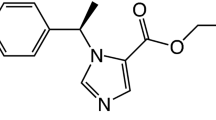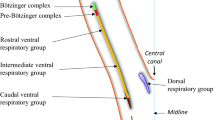Abstract
Purpose
Volatile anesthetics affect the circadian rhythm of mammals, although the effects of different types of anesthetics are unclear. Here, we anesthetized mice using several volatile anesthetics at two different times during the day. Our objective was to compare the effects of these anesthetics on circadian rhythm.
Methods
Male adult C57BL/6 J mice were divided into eight groups (n = 8 each) based on the anesthetic (sevoflurane, desflurane, isoflurane, or no anesthesia) and anesthesia time (Zeitgeber time [ZT] 6–12 or ZT18–24). Mice were anesthetized for 6 h using a 0.5 minimum alveolar concentration (MAC) dose under constant dark conditions. The difference between the start of the active phase before and after anesthesia was measured as a phase shift. Clock genes were measured by polymerase chain reaction in suprachiasmatic nucleus (SCN) samples removed from mouse brain after anesthesia (n = 8–9 each).
Results
Phase shift after anesthesia at ZT6–12 using sevoflurane (− 0.49 h) was smaller compared with desflurane (− 1.1 h) and isoflurane (− 1.4 h) (p < 0.05). Clock mRNA (ZT6–12, p < 0.05) and Per2 mRNA (ZT18–24, p < 0.05) expression were different between the groups after anesthesia.
Conclusion
0.5 MAC sevoflurane anesthesia administered during the late inactive to early active phase has less impact on the phase shift of circadian rhythm than desflurane and isoflurane. This may be due to differences in the effects of volatile anesthetics on the expression of clock genes in the SCN, the master clock of the circadian rhythm.





Similar content being viewed by others
Data availability
The data that support the findings of this study are available from the corresponding autho, upon reasonable request.
References
Allada R, Bass J. Circadian mechanisms in medicine. N Engl J Med. 2021;384:550–61.
Ludin NM, Orts-Secastian A, Cheeseman JF, Chong J, Merry AF, Cuminet D, Yamazaki S, Pawley MDM, Warman GR. General anaesthesia shifts the murine circadian clock in a time-dependant fashion. Clocks Sleep. 2021;3:87–97.
Imai R, Makino H, Katoh T, Kurita T, Hokamura K, Umemura K, Nakajima Y. Desflurane anesthesia shifts the circadian rhythm phase depending on the time of day of anesthesia. Sci Rep. 2020;10:18273. https://doi.org/10.1038/s41598-020-75434-6.
Li N, Stanewsky R, Popay T, Warman G, Cheeseman J. The effect of general anaesthesia on circadian rhythms in behaviour and clock gene expression of drosophila melanogaster. Clocks Sleep. 2020;23(2):434–41.
Kadota K, Iijima N, Hayashi Y, Takumi K, Higo S, Sakamoto A, Ozawa H. Time–dependent repression of mPer2 expression in the suprachiasmatic nucleus by inhalation anesthesia with sevoflurane. Neurosci Lett. 2012;528:153–8.
Challet E, Gourmelen S, Pevet P, Oberling P, Pain L. Reciprocal relationships between general (Propofol) anesthesia and circadian time in rats. Neuropsychopharmacology. 2007;32:728–35.
Wee BE, Turek FW. Midazolam, a short–acting benzodiazepine, resets the circadian clock of the hamster. Pharmacol Biochem Behav. 1989;32:901–6.
Montaigne D, Marechal X, Modine T, Coisne A, Mouton S, Fayad G, Ninni S, Klein C, Ortmans S, Seunes C, Potelle C, Berthier A, Gheeraert C, Piveteau C, Deprez R, Eeckhoute J, Duez H, Lacroix D, Deprez B, Jegou B, Koussa M, Edme JL, Lefebvre P, Staels B. Daytime variation of perioperative myocardial injury in cardiac surgery and its prevention by Rev-Erbα antagonism: a single–centre propensity–matched cohort study and a randomised study. Lancet. 2018;391:59–69. https://doi.org/10.1016/S0140-6736(17)32132-3.
Koike N, Yoo S, Huang H, Kumar V, Lee C, Kim T, Takahashi JS. Transcriptional architecture and chromatin landscape of the core circadian clock in mammals. Science. 2012;338:349–54.
Abrahamson EE, Moore RY. Suprachiasmatic nucleus in the mouse: retinal innervation, intrinsic organization and efferent projections. Brain Res. 2001;916:172–91.
Mori K, Iijima N, Higo S, Aikawa S, Matsuo I, Takumiet K, Sakamoto A, Ozawa H. Epigenetic suppression of mouse Per2 expression in the suprachiasmatic nucleus by the inhalational anesthetic, sevoflurane. PLoS One. 2014;9(1):e87319. https://doi.org/10.1371/journal.pone.0087319.
Cheeseman JF, Winnebeck EC, Millar CD, Kirkland LS, Sleigh J, Goodwin M, Pawley MDM, Bloch G, Lehmann K, Menzel R, Warman GR. General anesthesia alters time perception by phase shifting the circadian clock. Proc Natl Acad Sci U S A. 2012;109:7061–6.
Sonner JM, Gong D, Li J, Eger EI, Laster MJ. Mouse strain modestly influences minimum alveolar anesthetic concentration and convulsivity of inhaled compounds. Anesth Analg. 1999;89:1030–4.
Sato Y, Kobayashi E, Murayama T, Mishina M, Seo N. Effect of N–methyl–D–aspartate receptor epsilon1 subunit gene disruption of the action of general anesthetic drugs in mice. Anesthesiology. 2005;102:557–61.
Quasha AL, Eger EI, Tinker TH. Determination and applications of MAC. Anesthesiology. 1980;53:315–34.
Faul F, Erdfelder E, Lang AG, Buchner A. G*Power 3: a flexible statistical power analysis program for the social, behavioral, and biomedical sciences. Behav Res Methods. 2007;39:175–91.
Anzai M, Iijima N, Higo S, Takumi K, Matsuo I, Mori K, Ohe Y, Kadota K, Akimoto T, Sakamoto A, Ozawa H. Direct and specific effect of sevoflurane anesthesia on rat Per2 expression in the suprachiasmatic nucleus. PLoS One. 2013;8(3):e59454. https://doi.org/10.1371/journal.pone.0059454.
Ludin NM, Cheeseman JF, Merry AF, Millar CD, Warman GR. The effects of the general anaesthetic isoflurane on the honey bee (Apis mellifera) circadian clock. Chronobiol Int. 2016;33:128–33.
Xia T, Cui Y, Chu S, Ma S, Gu X. Murine clock gene expression in the suprachiasmatic nuclei and peripheral blood mononuclear cells during the daily sleep–wake rhythm and after isoflurane anesthesia. Sleep Biol Rhythms. 2015;13:357–65.
Xu Y, Tang P, Zhang W, Firestone L, Winter PM. Fluorine–19 nuclear magnetic resonance imaging and spectroscopy of sevoflurane uptake, distribution, and elimination in rat brain. Anesthesiology. 1995;83:766–74.
Venkatasubramanian PN, Shen YJ, Wyrwicz AM. Characterization of the cerebral distribution of general anesthetics in vivo by two–dimensional 19F chemical shift imaging. Magn Reson Med. 1996;35:626–30.
Kinjo S, Lim E, Magsaysay MV, Sands LP, Leung JM, Perioperative Medicine Research Group. Volatile anaesthetics and postoperative delirium in older surgical patients—a secondary analysis of prospective cohort studies. Acta Anaesthesiol Scand. 2019;63:18–26.
Chen G, Zhou Y, Shi Q, Zhou H. Comparison of early recovery and cognitive function after desflurane and sevoflurane anaesthesia in elderly patients: A meta–analysis of randomized controlled trials. J Int Med Res. 2015;43:619–28.
Rampil IJ. Anesthetic potency is not altered after hypothermic spinal cord transection in rats. Anesthesiology. 1994;80:606–10.
Katoh T, Suguro Y, Nakajima R, Kazama T, Ikeda K. Blood concentrations of sevoflurane and isoflurane on recovery from anaesthesia. Br J Anaesth. 1992;69:259–62.
Dwyer R, Bennett HL, Eger EI, Heilbron D. Effects of isoflurane and nitrous oxide in subanesthetic concentrations on memory and responsiveness in volunteers. Anesthesiology. 1992;77:888–98.
Chortkoff BS, Eger EI 2nd, Crankshaw DP, Gonsowski CT, Dutton RC, Ionescu P. Concentrations of desflurane and propofol that suppress response to command in humans. Anesth Analg. 1995;81:737–43.
Acknowledgements
We thank Rachel James, PhD ELS, from Edanz (https://jp.edanz.com/ac) and Mohamed Mthear Sahib Ibrahim Khaleelullah, PhD, Hamamatsu University School of Medicine for editing a draft of this manuscript.
Funding
This research was supported by grants-in-aid for scientific research (C) (grants 22K09044) from the Ministry of Education, Culture, Sports, Science, and Technology of Japan (Tokyo, Japan).
Author information
Authors and Affiliations
Contributions
All authors contributed to the study conception and design. Material preparation, data collection and analysis were performed by SS, RI and TK. The first draft of the manuscript was written by SS and RI and all authors commented on previous versions of the manuscript. All authors read and approved the final manuscript.
Corresponding author
Ethics declarations
Conflict of interest
The authors have no conflicts of interest to declare that are relevant to the content of this article.
Additional information
Publisher's Note
Springer Nature remains neutral with regard to jurisdictional claims in published maps and institutional affiliations.
Supplementary Information
Below is the link to the electronic supplementary material.
About this article
Cite this article
Sugimura, S., Imai, R., Katoh, T. et al. Effects of volatile anesthetics on circadian rhythm in mice: a comparative study of sevoflurane, desflurane, and isoflurane. J Anesth 38, 10–18 (2024). https://doi.org/10.1007/s00540-023-03262-9
Received:
Accepted:
Published:
Issue Date:
DOI: https://doi.org/10.1007/s00540-023-03262-9




